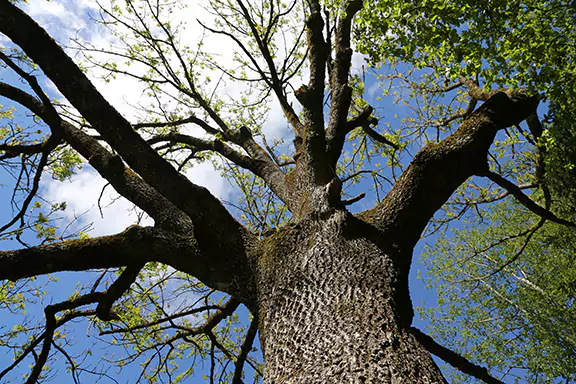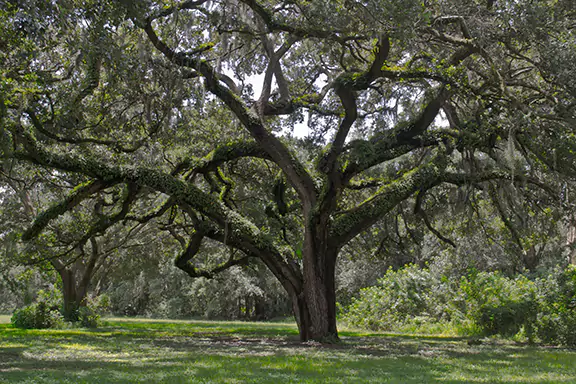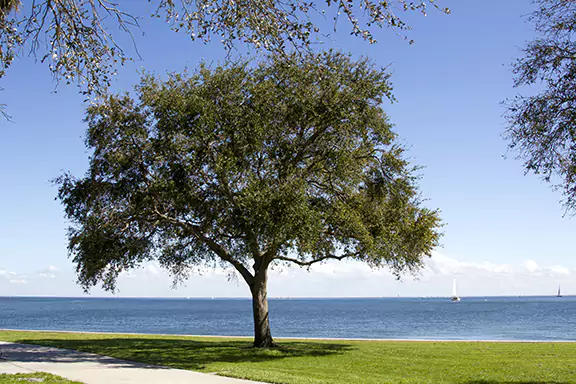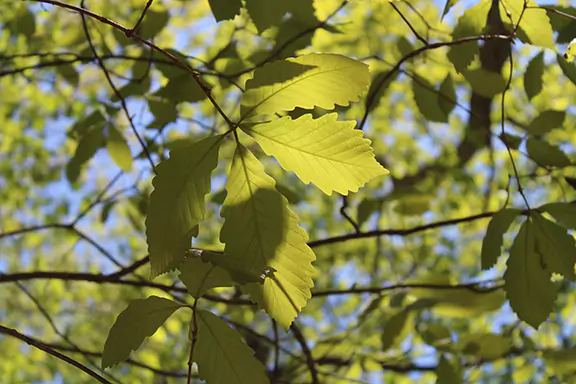Florida is home to a wide range of oak trees, each bringing unique charm, shade, and value to residential, commercial, and natural landscapes. From the towering southern live oak draped in Spanish moss to the sleek, fast-growing laurel oak, these trees are both ecologically vital and aesthetically appealing.
This guide explores the most common and iconic types of oak trees in Florida, highlighting how to identify oak trees, where they grow best, their pros and cons in landscaping, how they hold up in hurricanes, and what to know before planting or caring for one on your property.
Whether you’re a homeowner choosing an oak tree for decorative purposes, a property manager interested in storm resilience, or a contractor sourcing native species, understanding the nuances of Florida’s oak species can help you make informed and lasting decisions.

Laurel Oak (Quercus laurifolia)
1. Basic Identification
The laurel oak, or Quercus laurifolia, is one of Florida’s most recognizable oak trees, especially in urban and suburban settings. It features shiny green, lance-shaped leaves with smooth edges. It often holds onto its foliage longer than other deciduous oak trees, giving it a nearly evergreen tree appearance in milder winters.
Its bark is dark gray and relatively smooth when young, becoming light gray and slightly deeply furrowed as it matures. The leaf margins are typically entire or slightly wavy, not lobed, making it easy to distinguish them from more rugged oak species.
Height: 60–70 feet
Canopy Spread: 40–60 feet
Growth Rate: Fast
2. Where It's Found in Florida
The laurel oak thrives in central Florida, often in well-drained woods, city parks, and residential streets. It adapts well to sandy soils and tolerates partial shade, making it a common sight in developed and semi-natural areas.
3. Best Uses in Landscaping or Industry
Due to its rapid growth and symmetrical form, laurel oaks are popular for residential shade and commercial landscaping. They offer good canopy coverage quickly, ideal for cooling streets, parking lots, and backyards.
Pros: Fast growth, attractive shape, moderate maintenance
Cons: Shorter lifespan, weaker wood, more prone to storm damage
This tree is not ideal for planting near buildings or sidewalks due to aggressive root growth and potential structural risks over time.
4. Lifespan & Growth Habits
The laurel oak is a short-lived deciduous tree, typically surviving 50–70 years. It grows quickly—one of the fastest among Florida oak trees- both a benefit and a drawback. Rapid growth means faster shade but also more pruning and a shorter overall lifespan.
5. Hurricane Resistance & Structural Risk
Unfortunately, laurel oaks are not among the most wind-resistant oak trees native to Florida. Their shallow roots and fast growth make them more susceptible to breakage and uprooting during hurricanes, especially in saturated soils. Routine tree trimming and structural pruning can help reduce risk.
6. Common Health Issues & Warning Signs
Look for signs of root rot, limb dieback, or cankers—especially in older or poorly maintained trees. Because they grow so fast, they’re prone to internal decay that’s not always visible from the outside.
Warning Signs to Watch For:
Cracking bark
Hollow-sounding trunk
Early leaf drop or thinning canopy
Regular inspections are critical to avoid hazardous conditions, particularly near homes or high-traffic areas.
7. Tree Care Tips
Prune annually to maintain structure and remove deadwood
Water deeply during dry spells, especially for young trees
Avoid planting too close to structures or driveways due to aggressive roots
Use mulch to preserve soil moisture and protect roots
8. Cost & Planting Considerations
Cost to buy/install: $500+, depending on size
Easy to transplant when young
Requires space to accommodate its broad canopy and lateral root spread

Live Oak (Quercus virginiana)
1. Basic Identification
The live oak—scientifically known as Quercus virginiana—is perhaps the most iconic and widely recognized oak tree in Florida. Unlike most deciduous oak trees, the southern live oak is classified as an evergreen tree, meaning it retains its leaves through winter with only minor seasonal leaf drops.
It features dark green, thick, leathery leaves with smooth edges, and a sprawling canopy that can grow wider than the tree is tall. The bark is dark grayish to deeply furrowed, often hosting Spanish moss and other epiphytes in mature trees.
Height: 40–80 feet
Canopy Spread: Up to 100 feet
Growth Rate: Moderate to fast (depending on conditions)
2. Where It's Found in Florida
Native to nearly the entire state, the live oak flourishes in well-drained woods, pine flatwoods, coastal areas, and urban landscapes. It’s highly tolerant of sandy soils, salt spray, and partial shade, making it ideal for Florida’s diverse terrain.
3. Best Uses in Landscaping or Industry
The live oak is a top choice for residential and commercial landscaping, parks, and historic districts. Its majestic canopy and longevity make it a symbol of strength and endurance.
Pros: Long lifespan, high wind resistance, valuable wildlife habitat
Cons: Massive size requires lots of space, and an extensive root system may interfere with structures
It attracts and supports wildlife, offering shelter and food through acorns and leafy cover.
4. Lifespan & Growth Habits
Live oaks can live for centuries—some are documented as over 300 years old. They grow relatively fast in their youth and then settle into a steady, slow growth pattern. Their wide-spreading, low-branching form makes them excellent for shade but requires thoughtful placement and early training.
5. Hurricane Resistance & Structural Risk
The live oak is widely considered one of Florida’s best trees for hurricane resistance. Its deep root system, dense wood, and naturally wind-resistant shape allow it to withstand major storms better than most other oak species.
However, older or improperly pruned trees can still suffer damage. Proactive tree services, such as thinning and weight reduction, help maintain structural integrity.
6. Common Health Issues & Warning Signs
Live oaks are generally hardy but can still experience root rot, fungal infections, and pest issues like oak wilt or gall wasps. Watch for:
Mushrooms or fungal growth near the base
Yellowing or thinning leaves
Broken limbs or excessive dieback
Routine inspection and maintenance can catch problems early and prevent them from becoming hazardous.
7. Tree Care Tips
Tree trimming every 3–5 years to maintain healthy form, deadwood yearly to minimize the risk to property owner liability
Avoid excessive pruning that stresses the tree
Mulch to protect roots, especially in high-traffic areas
Allow plenty of space between structures and sidewalks to avoid root conflicts
8. Cost & Planting Considerations
Cost to buy/install: $500+, depending on size and age
Requires a large planting area
Can be transplanted when young, but prefers to establish early and remain undisturbed

Live Oak (Quercus virginiana)
1. Basic Identification
The water oak, or Quercus nigra, is a common deciduous oak tree known for its rounded, spoon-shaped leaves that are shiny green on top and lighter underneath. Its leaves often have smooth edges or very shallow lobes, making them easy to distinguish from deeply lobed oaks.
The bark is dark gray and relatively smooth when young, becoming deeply furrowed as the tree matures. It has a tall, straight trunk and a loosely rounded canopy that provides light shade.
Height: 50–80 feet
Canopy Spread: 30–50 feet
Growth Rate: Fast
2. Where It's Found in Florida
This species thrives in moist soils and is typically found along rivers, wetlands, and low-lying sandy soils across much of the state. It’s especially common in central Florida and is often used in suburban and rural landscapes.
Despite its name, it also adapts to drier, well-drained woods when young, though it’s less drought-tolerant than other oaks.
3. Best Uses in Landscaping or Industry
Due to its fast growth and upright form, the water oak is often used for quick shade in yards or along property lines.
Pros: Grows quickly, provides rapid canopy cover, adapts to various soil types
Cons: Short lifespan, brittle wood, high pruning needs, prone to root rot
It’s best for temporary use or as part of a transitional landscape plan rather than a permanent focal point.
4. Lifespan & Growth Habits
One of the shortest-lived oaks in Florida, the water oak typically survives only 30–50 years. Its rapid growth means it reaches maturity quickly but tends to decline sooner than other oak trees native to Florida.
Its upright structure and dense branching make it prone to developing co-dominant trunks and weak branch attachments, which can create maintenance issues over time.
5. Hurricane Resistance & Structural Risk
Water oaks do not hold up well in hurricanes. Their fast growth leads to less dense wood and a shallow root system, which increases the risk of failure during high winds or heavy rain.
They are considered high-risk trees during storm season, especially if not regularly pruned or thinned.
6. Common Health Issues & Warning Signs
As they age, these trees are particularly prone to root rot, cankers, and limb dieback. Look for:
Sudden leaf drop
Fungal growth at the base
Cracks or splits in the trunk
Because they decline quickly, early removal may be necessary to avoid property damage or injury.
7. Tree Care Tips
Begin tree trimming early in the tree’s life to develop a strong central leader
Remove deadwood and crossing branches annually
Avoid planting too close to structures due to root expansion
Monitor closely for signs of decline as it matures
8. Cost & Planting Considerations
Cost to buy/install: $500+ for nursery-grown saplings
Easy to establish, but should be planted where future removal won’t be disruptive
Not recommended as a legacy tree due to its short lifespan

Turkey Oak (Quercus laevis)
1. Basic Identification
The turkey oak, or Quercus laevis (also known as red oak), is a deciduous tree known for its distinctively lobed leaves resembling a turkey’s foot—hence the name. The leaves are often deeply lobed, with 3 to 7 narrow, finger-like points, and range from light green in spring to dark green in summer, turning reddish in the fall.
Its bark is dark gray and becomes deeply furrowed with age. Compared to broader-canopied oaks, the turkey oak has a more upright and open structure, which helps it shed wind more easily during storms.
Height: 20–40 feet
Canopy Spread: 15–30 feet
Growth Rate: Moderate to fast
2. Where It's Found in Florida
The turkey oak is native to dry, upland areas and is widespread in sandy soils across central Florida and the panhandle. It thrives in pine flatwoods and scrub habitats, often growing where other trees might struggle.
Its drought tolerance and adaptability make it an excellent choice for challenging sites with poor or compacted soil.
3. Best Uses in Landscaping or Industry
The turkey oak is ideal for naturalistic landscapes, xeriscaping, or restoration projects. Its small size makes it suitable for residential yards with limited space, and it provides valuable habitat and food for wildlife, particularly birds and small mammals.
Pros: Very drought-tolerant, low-maintenance, great for sandy and infertile soils
Cons: Smaller size limits shade potential, not ideal for formal landscapes
This tree is often overlooked in commercial settings but performs well in natural or native-themed installations.
4. Lifespan & Growth Habits
The turkey oak lives around 80–100 years under good conditions. While its growth rate is moderate, it establishes quickly and requires little care once it matures. Its rugged and informal nature makes it well-suited to rural or woodland-edge properties.
5. Hurricane Resistance & Structural Risk
Thanks to its shorter stature and flexible limbs, the turkey oak holds up well in storms and is not prone to uprooting or major limb failure. Its deep roots anchor it firmly even in sandy terrain, making it one of the more wind-stable oak species.
6. Common Health Issues & Warning Signs
The turkey oak is generally disease-resistant but can suffer from minor leaf fungi and root rot if overwatered or planted in poorly draining soils. Warning signs to watch include:
Wilting or discolored leaves in summer
Excessive leaf drop outside of seasonal patterns
Fungal conks or growth around the base
7. Tree Care Tips
Minimal pruning required; remove dead or crossed limbs every few years
Avoid overwatering; prefers dry conditions
Mulch to protect roots, but keep clear of the trunk base
Ideal for low-maintenance properties or native landscape designs
8. Cost & Planting Considerations
Cost to buy/install: $100–$300, depending on nursery and size
Easy to establish in dry soils
Often grown from seed in restoration projects due to its hardiness

Willow Oak (Quercus phellos)
1. Basic Identification
The willow oak, or Quercus phellos, stands out among oak trees in Florida due to its slender, willow-like leaves, long, narrow, and light green with smooth edges. Unlike most oak species with lobed or toothed leaves, this one closely resembles a willow tree, which makes it an excellent ornamental choice for a softer aesthetic.
Its bark is gray and smooth when young, becoming dark grayish and slightly deeply furrowed with age. The tree grows upright with a dense, rounded canopy.
Height: 50–80 feet
Canopy Spread: 30–50 feet
Growth Rate: Fast
2. Where It's Found in Florida
The willow oak is commonly found in central Florida and parts of the panhandle, often thriving near streams, well-drained woods, and low-lying sandy soils. It prefers moist, acidic soil but tolerates drier sites if established young.
3. Best Uses in Landscaping or Industry
This tree is a favorite for urban planning and commercial landscapes due to its uniform shape, fast growth, and ability to tolerate city conditions like compacted soil and pollution. It’s also gaining popularity in residential yards for its graceful appearance.
Pros: Fast growth, elegant form, low-maintenance
Cons: Roots may interfere with sidewalks or pipes, not ideal for small spaces
It’s also a good tree for attracting birds and squirrels, who feast on its small acorns.
4. Lifespan & Growth Habits
Willow oaks have a lifespan of about 80–100 years. They establish quickly and fill out with a symmetrical canopy, perfect for those who want rapid shade without the gnarled look of older oaks.
Its upright structure and columnar growth in early years also make it suitable for row plantings along driveways or boulevards.
5. Hurricane Resistance & Structural Risk
While not quite as storm-resistant as the live oak, the willow oak performs reasonably well in hurricanes when properly pruned. Its wood is strong but lighter than that of other oak trees, so routine tree trimming is important to prevent top-heavy issues.
Deep roots help with stability, but surface root exposure can occur in compacted soil or high-foot-traffic areas.
6. Common Health Issues & Warning Signs
Though generally hardy, the willow oak can experience:
Fungal diseases like anthracnose
Galls from insects
Root rot in poorly draining soil
Signs to monitor:
Browning or curling of evergreen leaves in non-deciduous seasons
Excessive limb drop or brittle branches
Mushrooms or decay at the base
7. Tree Care Tips
Start pruning early to establish a single leader and balanced canopy
Maintain 2–3 inches of mulch away from the trunk
Water regularly during the first 2–3 years to promote deep-root growth
Space appropriately to prevent sidewalk uplift from shallow roots
8. Cost & Planting Considerations
Cost to buy/install: $500–$600+, depending on size and supplier
Easy to find at nurseries due to high demand
Ideal spacing: 25–30 feet from structures or other trees

Swamp Chestnut Oak (Quercus michauxii)
1. Basic Identification
The swamp chestnut oak, also known as Quercus michauxii, is a tall, stately deciduous oak tree with light gray to gray bark that develops deep, blocky ridges as it matures. Its broad, deeply lobed leaves resemble those of the chestnut tree, with large, rounded teeth along the leaf margins.
The leaves are typically shiny green on top and lighter beneath, turning brilliant shades of red and brown in fall before dropping. It’s a tree that adds seasonal interest as well as structure.
Height: 60–100 feet
Canopy Spread: 40–60 feet
Growth Rate: Moderate
2. Where It's Found in Florida
The swamp chestnut oak is native to moist bottomlands, riverbanks, and low-lying forests, making it a natural fit for parts of central Florida and the state’s northern regions. It prefers well-drained woods that retain some moisture and thrives in sandy soils rich in organic material.
This oak is often found near water sources but performs well in landscape settings when watered consistently during establishment.
3. Best Uses in Landscaping or Industry
Due to its upright growth and tolerance for wet conditions, this tree is excellent for large residential lots, commercial sites with poor drainage, or as part of stormwater management landscaping.
Pros: Attractive foliage, fall color, wet-soil tolerance
Cons: Requires space, slow to establish compared to faster-growing oaks
It also supports wildlife with large, sweet-tasting acorns consumed by deer, squirrels, and birds.
4. Lifespan & Growth Habits
The swamp chestnut oak can live over 100 years when planted in the right environment. While its growth is slower in its early years, it becomes a deeply rooted, stable tree with a broad canopy and excellent structure for shade.
This makes it a great legacy tree for properties with space to let it grow.
5. Hurricane Resistance & Structural Risk
Thanks to its deep root system and dense wood, the swamp chestnut oak has good hurricane resistance once established. Its naturally balanced form also helps prevent tipping or major breakage.
However, younger trees need support during storms until their roots are well-developed. Regular tree trimming also helps reduce risk by managing canopy weight.
6. Common Health Issues & Warning Signs
This species is relatively disease-resistant, but it can experience:
Root rot in overly saturated or compacted soil
Insect infestations like caterpillars or scale
Fungal leaf spots in humid conditions
Keep an eye out for:
Yellowing leaves in summer
Mushrooms at the base
Significant leaf drop before fall
7. Tree Care Tips
Water consistently for the first 2–3 years
Prune in late winter to remove dead or crowded branches
Use mulch to retain soil moisture, but avoid piling near the trunk
Ideal for locations with periodic flooding or wet seasons
8. Cost & Planting Considerations
Cost to buy/install: $500+, depending on size
Plant in areas that can accommodate deep roots and high canopies
Allow plenty of space for air circulation to reduce fungal issues
Choosing the Right Oak Tree for Your Florida Property
Florida is rich in oak tree diversity, and each species offers its strengths—whether it’s the shade of a live oak, the fast growth of a laurel oak, the rugged resilience of a turkey oak, or the moisture tolerance of a swamp chestnut oak. Whether planning a new landscape, maintaining existing trees, or trying to identify oaks on your property, understanding the unique traits of each oak species helps you make smarter, more sustainable choices.
When choosing an oak for your home, business, or municipal property, consider:
Soil and space availability
Expected maintenance and lifespan
Storm resilience and structural safety
Wildlife and ecosystem benefits
Oaks are an investment in beauty, shade, and long-term value, but they also require the right care to thrive.
Expert Help for Healthy, Storm-Ready Oaks
At Berman Land & Property Solutions, we’ve spent over 20 years working with all types of oak trees in Florida. Whether you need professional help with tree trimming, planting advice, or emergency tree removal, our experienced, licensed team is here to help.
Contact us today for a free consultation.

